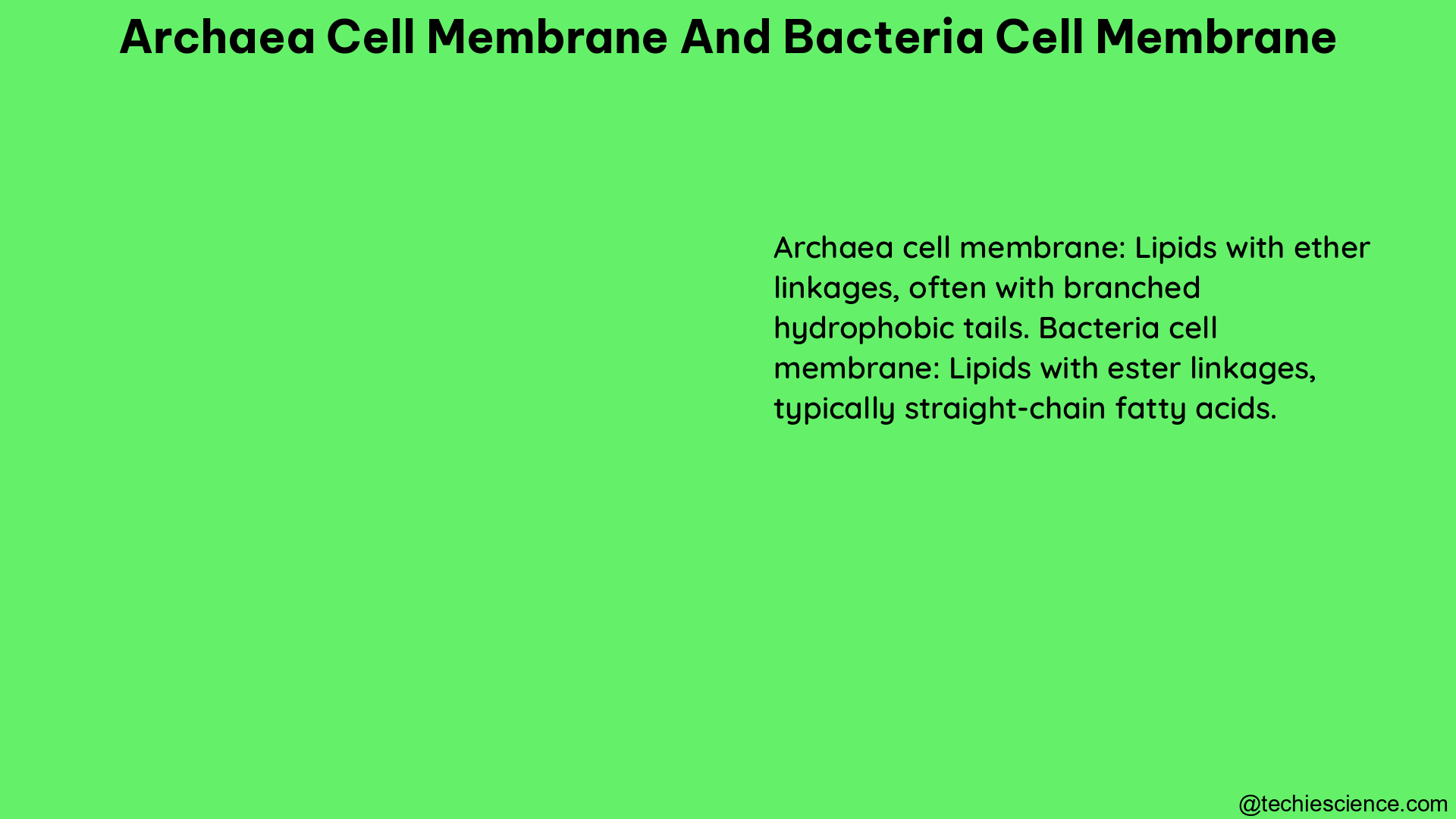The cell membrane is a crucial component for the survival of both bacteria and archaea, particularly in extreme environments. While bacteria and archaea are both prokaryotes, they exhibit distinct structural differences, including in their cell membranes.
Bacterial Cell Membranes
Bacterial cell membranes are composed of a lipid bilayer made up of fatty acids linked to glycerol. These fatty acids can vary in length and degree of saturation, which can affect the fluidity and permeability of the membrane. Bacterial cell membranes also contain a variety of proteins, including transport proteins, receptors, and enzymes, which play important roles in cellular processes.
One of the key features of bacterial cell membranes is the presence of peptidoglycan, a complex polymer that forms the cell wall. Peptidoglycan provides structural support and protection for the bacterial cell, and it also plays a role in cell division and shape maintenance.
Archaeal Cell Membranes

In contrast to bacterial cell membranes, archaeal cell membranes have a unique lipid composition. Instead of fatty acids linked to glycerol, archaeal membranes are composed of isoprene (phytanyl) chains linked to glycerol. This structural difference contributes to the ability of archaea to survive in extreme environments.
The presence of ether linkages and isoprenoid chains in archaeal cell membranes makes them more resistant to heat, acid, and other environmental stressors compared to bacterial membranes. This is particularly important for archaea that thrive in extreme environments, such as hydrothermal vents, hot springs, and hypersaline environments.
Some archaeal cell membranes are also lipid monolayers instead of the more common lipid bilayers found in bacteria and eukaryotes. This unique membrane structure may provide additional stability and resistance to environmental stressors.
Physical Properties of Archaeal Cell Membranes
In addition to their unique lipid composition, archaeal cell membranes may also have different physical properties compared to bacterial membranes. For example, some archaea have a specialized membrane structure called a “mesosome,” which is an invagination of the cell membrane. Mesosomes may play a role in DNA replication, cell division, and other cellular processes.
The fluidity and permeability of archaeal cell membranes can also be influenced by factors such as temperature, pH, and the presence of specific lipids. Archaea have developed various mechanisms to maintain membrane fluidity and permeability in response to environmental changes, including the production of specific lipids and the regulation of membrane-associated proteins.
Cell Wall Differences
In addition to differences in cell membrane composition, bacteria and archaea also exhibit distinct differences in their cell walls. Bacterial cell walls contain peptidoglycan, a complex polymer that provides structural support and protection.
In contrast, archaeal cell walls do not contain peptidoglycan. Instead, they may be composed of a variety of other materials, such as pseudopeptidoglycan, polysaccharides, glycoproteins, or protein-based cell walls. These alternative cell wall structures contribute to the unique properties and adaptations of archaea.
Quantifiable Data on Archaea and Bacteria
Numerous studies have provided quantifiable data on the relative abundance of archaea and bacteria in various environments. One study found that the ratio of archaea to bacteria increased significantly with depth in marine sediments, with archaeal cell densities decreasing more gradually than bacterial cell densities. This trend was consistent across individual sediment cores, with no cores showing a statistically significant decrease in the ratio of archaea to bacteria with depth.
Similar trends have been observed in seawater, where the ratio of archaea to bacteria has been shown to increase with depth. This suggests that the unique adaptations and properties of archaeal cell membranes may provide a competitive advantage in certain environments, particularly those characterized by high temperature, pressure, or other extreme conditions.
Conclusion
In summary, the cell membranes of bacteria and archaea exhibit distinct structural and compositional differences that contribute to their ability to survive in different environments. Archaeal cell membranes, in particular, have unique lipid compositions and physical properties that make them more resistant to environmental stressors compared to bacterial membranes.
The quantifiable data on the relative abundance of archaea and bacteria in various environments, such as the increasing ratio of archaea to bacteria with depth in marine sediments, further highlights the distinct biology and adaptations of these two groups of prokaryotes. Understanding the nuances of archaea and bacterial cell membranes is crucial for advancing our knowledge of microbial ecology, evolution, and biotechnological applications.
References:
– Archaea vs. Bacteria | Biology for Majors II. (n.d.). Retrieved from https://bio.libretexts.org/Bookshelves/Introductory_and_General_Biology/Book%3A_Biology_for_Majors_II_(Baum_et_al.)/07%3A_Prokaryotes/7.04%3A_Archaea_vs._Bacteria
– The Cell Biology of Archaea – PMC – NCBI. (2022-10-17). Retrieved from https://www.ncbi.nlm.nih.gov/pmc/articles/PMC3769989/
– Characterisation of a synthetic Archeal membrane reveals a … – Nature. (2021-06-02). Retrieved from https://www.nature.com/articles/s41586-021-03533-1
– Meta-Analysis of Quantification Methods Shows that Archaea and … (2013-10-01). Retrieved from https://www.ncbi.nlm.nih.gov/pmc/articles/PMC3789621/
I am Ankita Chattopadhyay from Kharagpur. I have completed my B. Tech in Biotechnology from Amity University Kolkata. I am a Subject Matter Expert in Biotechnology. I have been keen in writing articles and also interested in Literature with having my writing published in a Biotech website and a book respectively. Along with these, I am also a Hodophile, a Cinephile and a foodie.